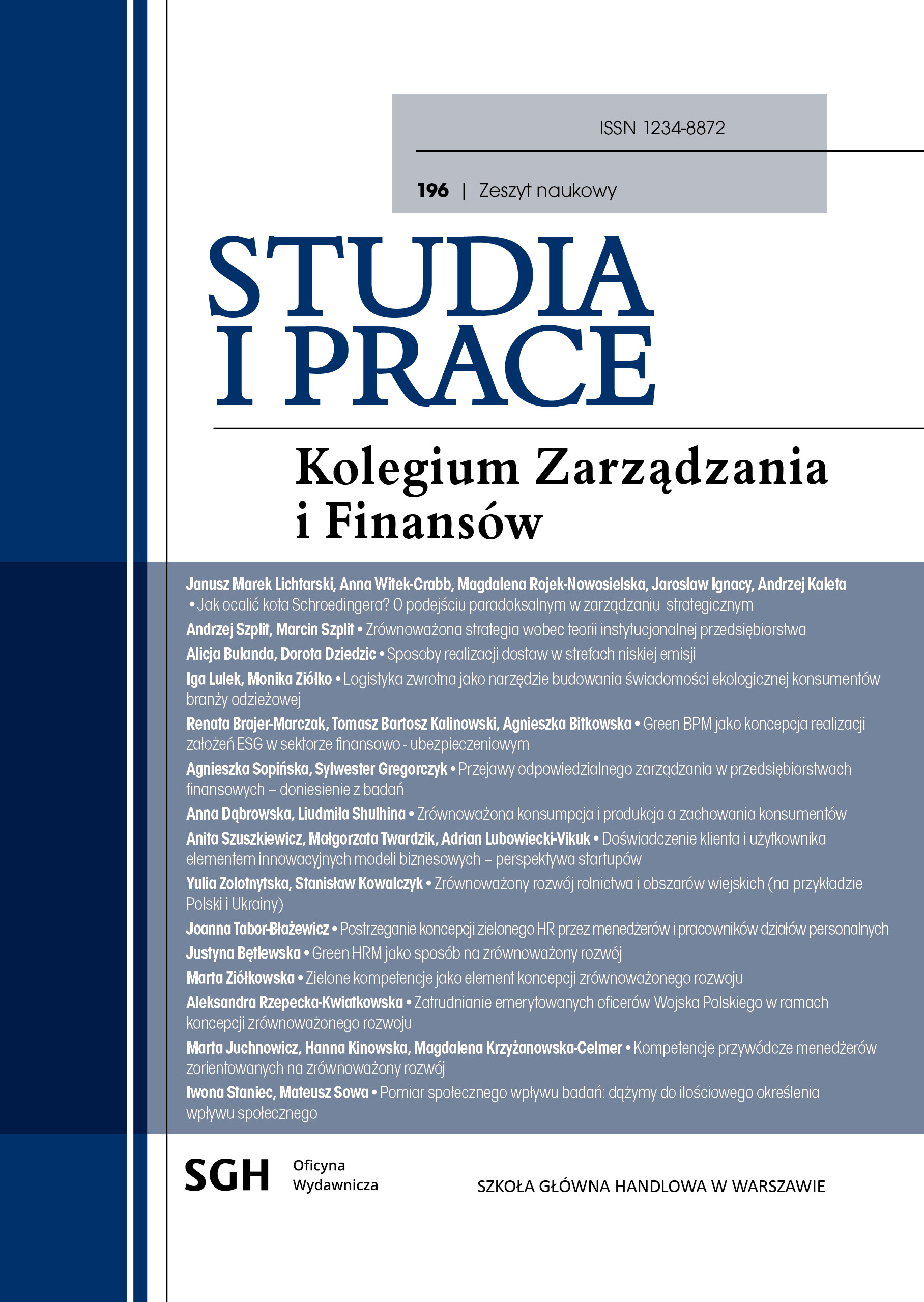Delivery methods in low emission zones
DOI:
https://doi.org/10.33119/SIP.2024.196.3Keywords:
transportation, low emission vehicles, deliveries, low emission zones, clean transport zonesAbstract
Industrial development and transportation have a negative impact on the environment. In response to this problem, low emission zones (in Poland called Clean Transport Zones) are being established in many European cities to reduce the negative effects of road transport on the environment. Therefore, logistics companies must adapt to the new requirements in order to continue providing transportation services in the areas covered by these zones. Making deliveries in these zones requires the use of innovative
solutions, such as the construction of hubs and microhubs, the use of low-emission vehicles (electric or hydrogen-powered), cargo bikes, or autonomous road robots. The purpose of the article is to review and compare the above-mentioned delivery methods, taking into account their advantages and disadvantages. The content of the article is based on an analysis of the literature on the subject.
Downloads
References
Dokumenty prawne
Ustawa z dnia 11 stycznia 2018 r. o elektromobilności i paliwach alternatywnych (Dz.U. 2018 poz. 317).
Wydawnictwa zwarte
Badyda, A., Dąbrowiecki, P., Jędrak, J., Konduracka, E. (2017). Wpływ zanieczyszczenia powietrza na zdrowie. Kraków: Krakowski Alarm Smogowy.
Budziszewska, M., Kardaś, A., Bohdanowicz, Z. (2023). Klimatyczne ABC. Interdyscyplinarne podstawy współczesnej wiedzy o zmianie klimatu. Warszawa: Wydawnictwa Uniwersytetu Warszawskiego.
Artykuły prasowe i okolicznościowe
Białokozowicz, A., Ryciuk, U. (2022). Wykorzystanie autonomicznych robotów dostawczych w usługach kurierskich ostatniej mili, Akademia Zarządzania, 6 (3), s. 387–404.
Chamberlain, R. C., Fecht, D., Davies, B., Laverty, A. A. (2023). Effects of low emission zones and congestion charging zones on physical health outcomes: a systematic review, Lancet Public Health, 8, s. e559–574.
Grabanski, S., Igliński, H., Szymczak, M. (2018) Transport niskoemisyjny i autonomiczny w dystrybucji. Problem dostaw ostatniej mili, Handel Wewnętrzny, 6 (377), s. 422–437.
Moral-Carcedo, J. (2022). Dissuasive effect of low emission zones on traffic: the case of Madrid Central, Transportation, 51, s. 25–49.
Pawłowski, S. (2022). Low Emission Zones a strefy czystego transportu w Polsce – trudne początki i prognozy, Studia Prawnoustrojowe, 58, s. 387–401.
Sendek-Matysiak, E. (2019). Ocena baterii litowo-jonowych stosowanych w samochodach elektrycznych typu BEV pod względem bezpieczeństwa i wpływu na środowisko, Problemy Transportu i Logistyki, 2 (46), s 59–68.
Zajkowski, K., Sroka, K. (2017). Przegląd możliwych sposobów ładowania akumulatorów w pojazdach z napędem elektrycznym, Autobusy: technika, eksploatacja, systemy transportowe, 7, s. 483–486.
Materiały internetowe
Azdad, Z., Stoll, B., Müller, J. (2022). CLEAN CITIES. The development trends od low- and zero-emission zones in Europe, Clean Cities Campaign, https://cleancitiescampaign.org/wpcontent/uploads/2022/07/The-development-trends-of-low-emission-and-zero-emissionzones-in-Europe-1.pdf (dostęp: 7.04.2024).
Brodacki, D., Dąbrowski, D., Mizak, J., Szałański, A. (2022). Transformacja ostatniej mili. Zeroemisyjność w logistyce miejskiej, Polityka Insight, https://www.politykainsight.pl/prawo/rankingkancelariiregulacyjnych/_resource/multimedium/20308460 (dostęp: 7.04.2024).
Ørving, T., Eidhammer, O. (2019). Evaluation of Oslo City Hub – The planning and establishment of a depot for transshipment of goods, https://www.toi.no/getfile.php?mmfileid=51225 (dostęp: 7.04.2024).
Kross (b.d.). E-CARGO 1.0 BUSINESS, https://kross.eu/pl/ebike/e-cargo/e-cargo-1-0‑business-szary-matowy (dostęp: 7.04.2024).
EEA Raport nr 2/2020, Transport and environment report 2021Decarbonising road transport–the role of vehicles, fuels and transport demand, https://www.eea.europa.eu/publications/transport-and-environment-report-2021 (dostęp: 7.04.2024).
VolvoTrucks (b.d.). Elektromobilność – to proste, https://www.volvotrucks.pl/pl-pl/trucks/alternative-fuels/electric-trucks.html (dostęp: 7.04.2024).
Ford Media (2023). Ford announces three-year hydrogen fuel cell E-Transit trial, https://media.ford.com/content/fordmedia/feu/gb/en/news/2023/05/09/ford-announces-three-year-hydrogen-fuel-cell-e-transit-trial.html (dostęp: 7.02.2024).
EDGAR (2023). GHG emissions of all world countries, https://edgar.jrc.ec.europa.eu/report_2023 (dostep: 7.02.2024).
Mayor of London (2023). Inner London Ultra Low Emission Zone Expansion One Year Report, https://www.london.gov.uk/programmes-strategies/environment-and-climate-change/environment-and-climate-change-publications/inner-london-ultra-low-emission-zone-expansion-one-year-report?auHash=IxeIM3L6iJh-CwYvb2wek2UKMCSJvpOqMgtpRAMt5B8 (dostęp: 7.02.2024).
Jowit, J. (2008). Q&A: London’s Low Emission Zone (LEZ), https://www.theguardian.com/environment/2008/feb/04/travelandtransport.carbonemissions (dostęp: 6.02.2024).
Lage-emissiezones (LEZ) (b.d.). https://www.vlaanderen.be/lage-emissiezones-lez (dostęp:6.02.2024).
Lampton, C. (b.d.). What are the benefits of hydrogen-powered vehicles?, https://auto.howstuffworks.com/fuel-efficiency/alternative-fuels/hydrogen-vehicle-benefit.htm (dostęp: 7.02.2024).
Périmètre Zone à Faibles Emissions mobilité (ZFEm) (b.d.). https://www.data.gouv.fr/en/datasets/perimetre-zone-a-faibles-emissions-mobilite-zfem/ (dostęp: 6.02.2024).
Smartload.pl (2021). Rodzaje pojazdów transportowych, https://smartload.pl/pl/transport/rodzaje-pojazdow-i-wymiary-naczep-transportowych (dostęp: 7.04.2024).
Scott, S. (2019). Meet Scout, https://www.aboutamazon.com/news/transportation/meet-scout (dostęp: 7.02.2024).
Sevino, V. (2022). AREA C and AREA B in Milan, https://www.ruedelavenir.com/wp-content/uploads/2022/06/9_Milan_Area_C-Area_B-ENG.pdf (dostęp: 7.02.2024).
Silverstein, S. (2022). Retail startup opens first frictionless grocery store, eyes 500 more, https://www.grocerydive.com/news/retail-startup-opens-first-frictionless-grocery-store-eyes-500‑more/618253/ (dostęp: 7.04.2024).
Ślęzak, M., Wiśniowski, P., Gis, M. (2015). Wodór jako paliwo w motoryzacji, http://plusuj.pl/index.php?option=com_content&view=article&id=354%3Apraktyczna-szkoa-modelowania--molekularnego-iii&Itemid=58 (dostęp: 7.02.2024).
Umweltzonen in Deutschland (2024). https://www.umweltbundesamt.de/themen/luft/luftschadstoffe/feinstaub/umweltzonen-in-deutschland#1‑wie-ist-der-aktuelle-stand-der-umweltzonen (dostęp: 6.02.2024).
Veelgestelde vragen (b.d.). https://www.milieuzones.nl/veelgestelde-vragen (dostęp: 6.02.2024).
Transport of London (b.d.). Ways to meet the LEZ standards, https://tfl.gov.uk/modes/driving/low-emission-zone/ways-to-meet-the-standards (dostęp: 7.02.2024).
ZTL | Zone a traffico limitato, corsie riservate, aree pedonali (b.d.). https://www.comune.milano.it/aree-tematiche/mobilita/ztl-zone-a-traffico-limitato-corsie-riservate-aree-pedonali (dostęp: 6.02.2024).
Downloads
Published
How to Cite
Issue
Section
License
Copyright (c) 2024 Studies and Work of the Collegium of Management and Finance

This work is licensed under a Creative Commons Attribution 4.0 International License.









